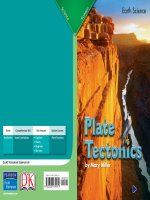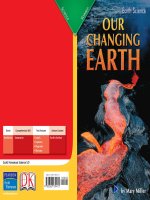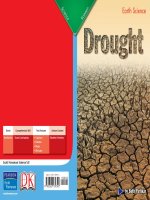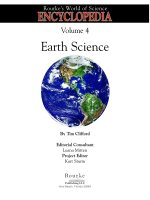4 7 hurricanes (earth science)
Bạn đang xem bản rút gọn của tài liệu. Xem và tải ngay bản đầy đủ của tài liệu tại đây (2.54 MB, 10 trang )
Genre
Nonfiction
Comprehension Skill
Main Idea and Details •
•
•
•
Text Features
Captions
Labels
Diagrams
Glossary
Science Content
Severe Storms
Scott Foresman Science 4.7
ISBN 0-328-13879-7
ì<(sk$m)=bdihjb< +^-Ä-U-Ä-U
Vocabulary
Extended Vocabulary
hurricane
storm surge
tornado
tropical depression
tropical storm
vortex
atmospheric pressure
cyclones
landfall
lull
torrential
typhoons
wall clouds
What did you learn?
1. Why are hurricanes such dangerous
weather events?
2. List two factors that must be present
in order for a hurricane to form.
3. Explain how a storm surge happens.
by Peggy Bresnick Kendler
Picture Credits
Every effort has been made to secure permission and provide appropriate credit for photographic material.
The publisher deeply regrets any omission and pledges to correct errors called to its attention in subsequent editions.
Photo locators denoted as follows: Top (T), Center (C), Bottom (B), Left (L), Right (R), Background (Bkgd).
Opener: The Science Museum/©DK Images;1 ©Bettmann/Corbis; 4 (B, BR) Getty Images; 5 (BR) The Cinema Museum/
Ronald Grant Archive; 6 (TL) ©Bettmann/Corbis, (BL) The Science Museum/©DK Images, (T) Schenectady Museum/
Hall of Electrical History Foundation/Corbis, (CR) Brand X Pictures; 8 (TL) ©Bettmann/Corbis, (B) Science Museum,
London/DK Images; 9 (TR) ©Alfred Pasieka/Photo Researchers, Inc.; 10 (TL) ©Bettmann/Corbis; 11 (CR) Reuters/Corbis;
12 (TL) ©Bettmann/Corbis, (B) Science Source/Photo Researchers, Inc.; 14 (TL) Hulton-Deutsch Collection/Corbis.
Unless otherwise acknowledged, all photographs are the copyright © of Dorling Kindersley, a division of Pearson.
ISBN: 0-328-13879-7
Copyright © Pearson Education, Inc. All Rights Reserved. Printed in the United States of America.
This publication is protected by Copyright, and permission should be obtained from the publisher prior to any
prohibited reproduction, storage in a retrieval system, or transmission in any form by any means, electronic,
mechanical, photocopying, recording, or likewise. For information regarding permission(s), write to
Permissions Department, Scott Foresman, 1900 East Lake Avenue, Glenview, Illinois 60025.
3 4 5 6 7 8 9 10 V010 13 12 11 10 09 08 07 06 05
4.
Scientists and
meteorologists have ways to monitor
storms such as hurricanes. Write to
describe some of the ways they do this.
Use details from the book to support
your answer.
5.
Main Idea and Details Hurricanes
are severe storms. What details from
the book support this idea?
What You Already Know
A hurricane is a dangerous storm with very strong
winds. A hurricane is made up of many groups of
thunderstorms that are wrapped around its center.
Tropical storms form from heat and water vapor
from the ocean. Warm, moist air rises, causing a tropical
disturbance. The clouds in a tropical disturbance can
become thunderstorms. The storms’ winds increase
and begin to swirl, causing a tropical depression. Winds
blow faster and form a tropical storm. When winds
reach a speed of 119 kilometers per hour, the tropical
storm becomes a hurricane. The center of a hurricane is
called the eye. Winds are calm in the eye.
A hurricane can knock down trees or change the
shape of a coastline. A slow-moving hurricane can
produce many inches of rain in one place. This can
cause dangerous mudslides and floods. A hurricane’s
winds can push large waves of ocean water onto the
shore. This rise in sea level is called a storm surge.
Computer models can predict a hurricane’s strength,
direction, and speed. Satellites can send data on
storms and hurricanes to meteorologists. Many
scientists work together to forecast storms.
2
A funnel cloud is a rapidly spinning column
of air that drops down out of a thunderstorm.
It is called a tornado when it touches the ground.
A tornado forms from a spinning area
inside a thunderstorm. A vortex is an
area where air or liquid spins in circles.
A tornado is a vortex that forms in
a thunderstorm.
Tornadoes form and move
quickly. They are difficult
to forecast. Their strong
winds can cause a great
deal of damage.
Hurricanes and
tornadoes are both strong
storms. Tornadoes have
faster winds than hurricanes
have. Hurricanes are bigger
than tornadoes, and they last
longer. Keep reading to learn
more about hurricanes.
3
What are hurricanes?
Hurricanes are very large
tropical storms that form
over warm water. Hurricanes,
typhoons, and cyclones are all
different names for the same
type of storm. In the western
Pacific Ocean, hurricanes are
called typhoons. In the Indian
Ocean, they are called cyclones. satellite image of a hurricane
In the Atlantic Ocean, they are
called hurricanes.
Hurricanes have winds that have reached a
constant speed of at least 119 kilometers per hour.
These winds blow in a spiral pattern around a calm
center area called the eye.
The eye of a hurricane
is usually between twenty
and one hundred kilometers
wide. The storm can bring
heavy rains, powerful winds,
and storm surges. A single
hurricane can spend more
than two weeks over open
water.
Hurricane season in the
Atlantic Ocean north of
the equator lasts from June 1
through November 30. During
these months, the water in the
Atlantic Ocean is warmest.
Most hurricanes happen in
August and September.
Storm Names
All tropical storms
are given male
or female names.
The names help
meteorologists
identify and track
storms—especially
when more than
one happens at the
same time.
The strong winds of a hurricane
can knock over trees.
4
5
How Hurricanes Form
Hurricanes start as small thunderstorms over warm,
tropical oceans. They begin over a warm layer of water
at the top of the sea. This layer has a surface temperature
of at least 26.5˚ Celsius, or 80˚ Fahrenheit. The warm
seawater is absorbed by the air. This moist, warm air
affects the atmospheric pressure. Atmospheric pressure
is the pressure caused by the
weight of air.
The map shows the places
where severe storms are
most likely.
Most hurricanes in North America happen when
different water currents meet. When these currents
come together, they produce a group of thunderstorms
called a tropical disturbance. The disturbance grows as
warm, moist air moves upward. As the air rises, it cools
and the water in it condenses and releases heat. This
causes lower atmospheric pressure, which pulls even
more air into the system.
As the wind moves faster, the tropical disturbance
becomes a tropical depression. As air moves into it, the
system begins to spin around. When the storm’s winds
grow to 62 kilometers per hour or greater, it becomes a
tropical storm, and it is given a name. If the storm keeps
growing and its wind speeds reach 119 kilometers per
hour, it is a hurricane.
Hurricane Mitch 1998
October 22, 1998: A storm
begins to form over the
Atlantic Ocean.
6
October 25, 1998: As the storm
develops into a hurricane, the
eye becomes visible.
October 26, 1998: Hurricane
Mitch becomes larger and
more powerful.
October 28, 1998: After it
reaches land, Hurricane Mitch
loses strength.
7
Inside a Hurricane
At Earth’s surface, the air pressure in a
hurricane is low. When the air moves from areas
of high pressure to areas of low pressure, strong
winds develop. The warm, moist air from the
ocean moves to areas of low pressure. There the
air rises and forms bands of rain. These rain
bands can produce more than five centimeters of
rain per hour.
The powerful winds of a hurricane swirl
around the eye of the storm. A hurricane’s
eye is calm. Within the eye, there are few
winds or clouds.
hurricane structure
fastest winds spiral
around eyewall
spiraling bands
of wind and rain
8
Storm clouds called wall clouds surround
the eye to form the eyewall. A hurricane’s
strongest winds and heaviest rains happen
within wall clouds that spin around the eye. In
the eyewall, warm air spirals upward, causing
the most powerful winds of the storm.
9
Storm Damage
When a hurricane strikes land, we say it has made
landfall. As the hurricane moves over land, powerful
winds and heavy rains can remain over an area for several
hours. Its raging winds can reach a speed of more than
250 kilometers per hour. The winds and rains can do
tremendous damage. Hurricane winds can rip trees out
of the ground, tear the roofs off buildings, and shatter
windows. The torrential rains can cause heavy flooding.
10
As the hurricane’s eye passes over an area, the
winds slow and the sky might clear. There is a lull, or
a brief calm, in the storm. When the lull passes, the
intense winds and heavy rains resume. This is because
the most powerful winds of the storm surround the
hurricane’s eye.
Hurricanes weaken as they move over land. They
need energy from the warm sea air to stay powerful.
This destruction was
caused by Hurricane
Frances, which battered
Florida in 2004.
11
Storm Surge
A hurricane can cause storm surges. A storm surge
occurs when the hurricane pushes ocean water onto
the shore. During a hurricane, ocean water is pulled up
into the eye. This makes enormous waves that gain even
more power from the strong hurricane winds. The result
is a wall of seawater that crashes onto land.
Some of the worst damage from a hurricane is
caused by storm surges. They are especially dangerous
in areas where the coast is at almost the same level as
the ocean. During a storm surge, ocean water pours
onto land with tremendous force, flooding streets
and buildings. Buildings on hills are not as likely to
flood, but they are sometimes damaged by
mudslides that result from the heavy rain.
Besides flooding coastal areas, storm surges can do
plenty of damage to property. Rapid rises in sea level can
damage or destroy portions of bridges. Storm surges also
can lift large boats, wrecking
them as they wash up on the
shore or even onto roads.
Storm surges can also be
very dangerous for animals
and people who
get caught in the
rushing water.
Waves pounded the island
of Bermuda as a hurricane
struck in 2003.
Storm surges form when
ocean water is pulled into
the hurricane’s eye.
When Hurricane Frances
struck Florida in 2004, some
boats were washed inland.
12
13
Monitoring Storms
Predicting and tracking hurricanes are important
jobs of weather forecasters and meteorologists. They
alert people to the growing storm. People in areas
where the hurricane might strike have time to prepare
for the storm.
Weather forecasters use images from satellites
to help them follow a hurricane’s development over
the ocean. The images help them track a hurricane’s
progress and its path. This way, the forecasters can have
a good idea where the storm will make landfall.
The National Oceanic and Atmospheric
Administration, known as NOAA, sends specially
equipped planes to fly right into the center of
hurricanes. The planes carry meteorological equipment
that gathers data inside the storms. The data are fed
into computer models that help forecasters make
accurate predictions during a hurricane. Data also help
researchers better understand what goes on inside
storms and hurricanes.
This information
helps meteorologists
to be better hurricane
forecasters.
Meteorologists study
satellite images to help
them understand and
predict hurricanes.
14
A weather-research plane flies
into the eye of a hurricane to
gather information and monitor
the storm.
Devices on the weather-research planes measure air
pressure, humidity, temperature, and wind direction and
speed. This gives scientists a good idea of the structure
and intensity of the storm.
Hurricanes are very powerful storms. They can
cause great damage when they reach land. Their strong
winds and heavy rains can destroy anything in their
path. Scientists study hurricanes so they can learn as
much as possible about these dangerous storms.
15
Vocabulary
Glossary
hurricane
Extended Vocabulary
atmospheric pressure
storm surge
cyclones
tornado
landfall
atmospheric
the pressure
caused by the weight
tropical
depression
lull
pressure
of the atmosphere
tropical storm
torrential
vortex
cyclones
hurricanes typhoons
that form in the
wall
Indian Ocean clouds
landfall
the act of a hurricane reaching land
lull
a brief calm
torrential
flowing rapidly
typhoons
hurricanes that form in the western
Pacific Ocean
Picture Credits
Every effort has been made to secure permission and provide appropriate credit for photographic material.
The publisher deeply regrets any omission and pledges to correct errors called to its attention in subsequent editions.
wall clouds
the storm clouds that surround a
hurricane’s eye
Photo locators denoted as follows: Top (T), Center (C), Bottom (B), Left (L), Right (R), Background (Bkgd).
Opener: The Science Museum/©DK Images;1 ©Bettmann/Corbis; 4 (B, BR) Getty Images; 5 (BR) The Cinema Museum/
Ronald Grant Archive; 6 (TL) ©Bettmann/Corbis, (BL) The Science Museum/©DK Images, (T) Schenectady Museum/
Hall of Electrical History Foundation/Corbis, (CR) Brand X Pictures; 8 (TL) ©Bettmann/Corbis, (B) Science Museum,
London/DK Images; 9 (TR) ©Alfred Pasieka/Photo Researchers, Inc.; 10 (TL) ©Bettmann/Corbis; 11 (CR) Reuters/Corbis;
12 (TL) ©Bettmann/Corbis, (B) Science Source/Photo Researchers, Inc.; 14 (TL) Hulton-Deutsch Collection/Corbis.
Unless otherwise acknowledged, all photographs are the copyright © of Dorling Kindersley, a division of Pearson.
ISBN: 0-328-13879-7
Copyright © Pearson Education, Inc. All Rights Reserved. Printed in the United States of America.
This publication is protected by Copyright, and permission should be obtained from the publisher prior to any
prohibited reproduction, storage in a retrieval system, or transmission in any form by any means, electronic,
mechanical, photocopying, recording, or likewise. For information regarding permission(s), write to
Permissions Department, Scott Foresman, 1900 East Lake Avenue, Glenview, Illinois 60025.
3 4 5 6 7 8 9 10 V010 13 12 11 10 09 08 07 06 05
16
What did you learn?
1. Why are hurricanes such dangerous
weather events?
2. List two factors that must be present
in order for a hurricane to form.
3. Explain how a storm surge happens.
4.
Scientists and
meteorologists have ways to monitor
storms such as hurricanes. Write to
describe some of the ways they do this.
Use details from the book to support
your answer.
5.
Main Idea and Details Hurricanes
are severe storms. What details from
the book support this idea?









